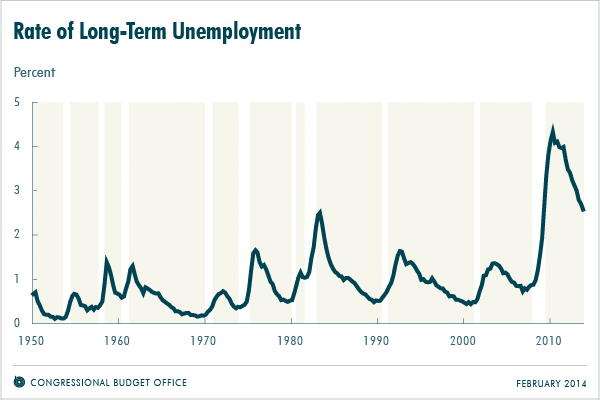Congressional Budget Office
U.S. Labor Market Has Recovered Slowly and Only Partially Since the End of the Recession
posted by David
Brauer & Charles Whalen on February
27, 2014
As a companion to CBOfs The Budget and Economic Outlook:
2014 to 2024 released earlier this month, CBO released The
Slow Recovery of the Labor Market—a report that takes a closer look at
developments in the labor market since the recent recession and CBOfs
projections for the labor market for the next decade.
The Slow Recovery of the Labor Market Largely Reflects Slow Growth in Demand
for Goods and Services
The deep recession that began in December 2007, when the economy began to
contract, and ended in June 2009, when the economy began to expand again, has
had a lasting effect on the labor market. More than four and a half years after
the end of the recession, employment has risen sluggishly—much more slowly than
it grew, on average, during the four previous recoveries that lasted more than
one year. At the same time, the unemployment rate has fallen only partway back
to its prerecession level (as shown in yesterdayfs blog
post), and a significant part of that improvement is attributable to a
decline in labor force participation that has occurred as an unusually large
number of people have stopped looking for work (see the figure below). Moreover,
the rate of long-term unemployment—the percentage of the labor force that has
been out of work for more than 26 consecutive weeks—remains extraordinarily
high.

To a large degree, the slow recovery of the labor market reflects the slow
growth in the demand for goods and services, and hence gross domestic product
(GDP). CBO estimates that GDP was 7½ percent smaller than potential (maximum
sustainable) GDP at the end of the recession; by the end of 2013, less than
one-half of that gap had been closed. With output growing so slowly, payrolls
have increased slowly as well—and the slack in the labor market that can be seen
in the elevated unemployment rate and in part of the reduction in the rate of
labor force participation mirrors the gap between actual and potential GDP.
To a smaller degree, the slow recovery of the labor market is the result of
structural factors that stem from the recession and the slow recovery of output
but that are not directly related to the economyfs current cyclical weakness.
For example, an exceptionally large number of people have been unemployed for
long periods, and the stigma attached to their long-term unemployment, along
with a possible erosion of their job skills, has made it difficult for them to
find new work.
In assessing the slow recovery of the labor market, CBO reached the following
conclusions:
- Of the roughly 2 percentage-point net increase in the unemployment
rate between the end of 2007 and the end of 2013, the portions that
can be attributed to different factors are shown in the table
below.
| Percentage
Points |
|
| About 1 |
Cyclical weakness in demand for goods and services |
| About 1 |
Structural factors—specifically: |
| |
About ½ |
Stigma and erosion of skills from long-term unemployment |
| |
About ½ |
Decrease in efficiency of matching workers and jobs, at least
partly from mismatches in skills and locations |
- Of the roughly 3 percentage-point net decline in the labor force
participation rate between the end of 2007 and the end of 2013, the
portions that can be attributed to different factors are shown in the table
below.
| Percentage Points |
|
| About 1 ½ |
Long-term trends (primarily aging of the population) |
| About 1 |
Cyclical weakness in job prospects and wages |
| About ½ |
Discouraged workers who have dropped out of the labor force
permanently |
- Employment at the end of 2013 was about 6 million jobs
short of where it would be if the unemployment rate had returned to
its prerecession level and if the participation rate had risen to the level it
would have attained without the current cyclical weakness. Those factors
account roughly equally for the shortfall.
Over the Next Decade: A Strengthening Economy but Slow Growth in the Labor
Force
CBO expects that, under current laws governing federal taxes and spending,
output will grow more rapidly in the next few years than it has in the recent
past but recovery in the labor market will continue for some time. The agency
projects that by the second half of 2017, the gap between actual and potential
GDP will return to its average historical relationship—bringing the effects of
cyclical conditions on unemployment and labor force participation back to their
average values in 2018.
However, CBO projects, the aging of the population will further reduce labor
force participation during the coming decade, and the longer-lasting effects of
the recession and slow recovery on unemployment and the size of the labor force
will continue, albeit with diminishing magnitude, throughout the decade. All
told, CBO projects that the unemployment rate will fall to 5.8 percent by the
end of 2017 and to 5.5 percent by 2024 (compared with 4.8 percent at the end of
2007) and that the labor force participation rate will decline to 60.8 percent
by 2024 (compared with 66.0 percent at the end of 2007; see figure below).

The pace and nature of the economic recovery have been difficult to predict,
and the path of the economy and the labor market will no doubt hold surprises as
well. CBOfs projections of the labor market are subject to several sources of
uncertainty, and many developments could cause outcomes substantially different
from those CBO has projected.
David Brauer and Charles Whalen are analysts in CBOfs Macroeconomic
Analysis Division.

